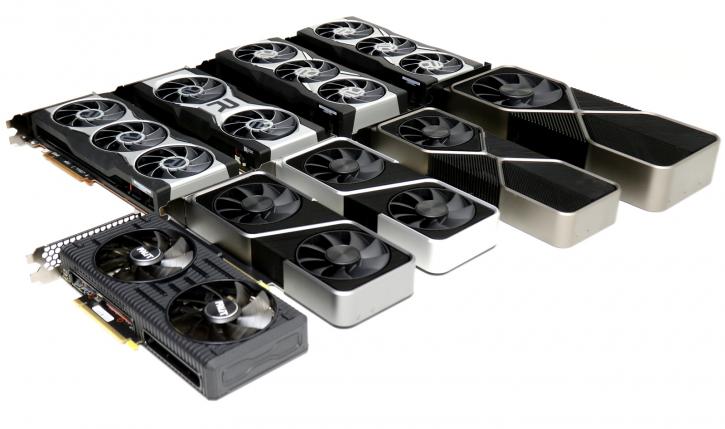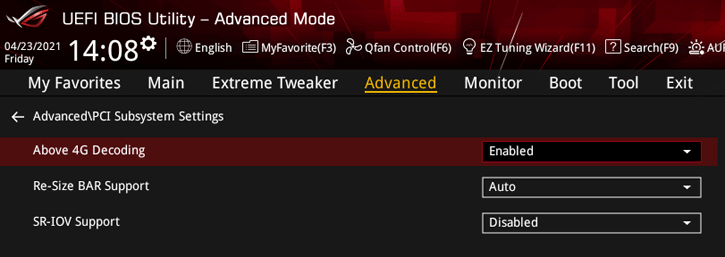Article - Guide - Review
Resizable BAR tested: Nvidia GeForce RTX 3000 and Radeon RX 6000
A couple of months ago, AMD introduced SAM, aka Smart Access memory, which really is PCI-Express Resizable BAR. And easy op[tion that possibly can bring extra performance. We test and benchmark this feature on all compatible graphics cards and will try and show you if it is worth the hassle of getting Resize Bar compatible.
Here at Guru3D, our test suite is based on games tested on both Intel and AMD platforms. AMD recently introduced a new series of motherboard AGESA BIOSes, and the late march drivers can have a positive effect on performance. As such, a re-test of many titles was due for an update. The recent Hitman 3 update, for example, shows a negative performance effect on AMD Radeon performance. In contrast, CyberPunk 2077 brought non-SAM results close to SAM-enabled results (after the most recent update). In short, our benchmark results for the AMD platform needed to be retested, and as such, we figured to test a good chunk of games with the new PCIe Resizable BAR feature with the Radeon RX 6700 XT, 6800, 6800 XT, and 6900 XT. Initially, the SAM / Resize BAR / rBAR made a substantial difference for some games. However, with the latest drivers and AGESA BIOS updates, that gap narrowed down quite a bit, raising the question if early SAM/Resize BAR results actually have been affected by something other than SAM. On its end, NVIDIA, a few weeks or so ago, also started offering Resizable BAR compatible BIOSes and driver support for the RTX 3060, 3060 Ti, 3070, 3080, and 3090. That meant retesting nine graphics cards over a suite of software; considering we can no longer use older benchmark results, we had to perform an A-B test, meaning the same setup configured with the same drivers and then Resizeable BAR on and off. That means 414 test runs for this article + added frame time tests, which was a daunting and time-consuming task, really.
Resize Bar / Smart Access Memory (SAM) ... what is that?
Resizable BAR actually is nothing new; the processor can access the graphics card memory via the PCIe bus, which has been included in the PCIe specifications for a long time. Basically, it was invented to help out integrated graphics processors perform a bit better. However, that old resize Bar feature can now make use of the entire graphics card memory as opposed to a small chunk of it.
AMD noticed that it could help a bunch of games in performance, and they do love stuff that is free to perform some marketing on stuff and create hype/virals. As such, at the Radeon 6000 series release, they marketed their implementation labeled "SAM," initially offering great differences in some, but certainly not the majority of games. So, Resize BAR compatible processors can get full access to your graphics card memory. Normally you are limited to a maximum block of 256MB. Smart Access Memory or Resize BAR (same thing) thus efficiently uses the combined memory of the CPU and GPU. This helps to reduce buffering can lower latency. It utilizes the PCI-express (high-speed and underutilized these days) bus to make that happen. Some games can benefit a few percent, others 5%, or even 10% from what we have seen. The vast majority, however, hardly benefit from it all. Also, to get things going, there are mandatory steps and procedures to tackle. ReSize BAR requires that CSM Support is turned off in the BIOS to enable an above 4G decode function, which will allow Resizable Bar Support (SAM) to be enabled. The Compatibility Support Module (CSM) is a component of the UEFI firmware that provides legacy BIOS compatibility by emulating a BIOS environment, allowing legacy operating systems and some option ROMs that do not support UEFI to be still used. One problem here is that if your Windows installation is already configured as non-UEFI, Windows will be unable to boot in that new condition. To test it, you would need to reinstall Windows with CSM support disabled and a GPT formatted storage unit.
Before you even opt for this, early supported motherboard BIOS firmware all have been flakey. We've seen several issues where we ran into system locks or black screens once we swapped graphics cards, for example. Ergo, it is mandatory to update to the latest BIOS update for your motherboard. Our ASUS X570 HERO runs absolutely perfect after we updated to the latest test revision. It really does make all the difference.
Once your motherboard firmware is updated, to get this feature supported in your BIOS:
- Disable CSM
- Enable Above 4G to decode and Re-size BAR support is often found in the PCIe Subsystem settings under advanced in the BIOS (ASUS). For a Gigabyte motherboard, this is located under IO settings in the BIOS for MSI under the Advanced - PCIe Subsystem.
- Your SSD/HDD must be EUFI GOP booted and should be GPT formatted, not MBR.
There's more to it though, procs and motherboards need to be compatible. Looking at AMD, currently, Ryzen 3000 (Zen 2) and Ryzen 5000 (Zen 3) processors support Resize BAR, including the most recent motherboards chipsets. Motherboard manufacturers are still heavily at work releasing compatible BIOSes, though. However, for most series 500 and some 400 motherboards, you should be able to the firmware update with Resize BAR compatibility.
Intel also jumped onto this; technically, anything starting at 4th Gen "Haswell" would be a compatible processor series-wise. However, here the motherboards are a big hurdle; they need a valid compatible BIOS. Currently, we're seeing lots of Z590 B550 and Z490 motherboards being updated with compatibility firmware. But anything below we doubt would get proper support. So let's say anything Coffee lake architecture processor (Core Gen9) and above should be or become compatible soon.
But wait, Dave, there's more ...
Last but not least. Mandatory is a compatible graphics card, e.g., the NVIDIA GeForce RTX 30-series or AMD RX 6000 series. If you own a 3060 Ti, 3070, 3080, and 3090, you'll need to perform a vBIOS update to get Resize BAR going. When all conditions are met, you can successfully boot into windows with Resize BAR enabled.
How to check if it's working?
When AMD started marketing SAM/Resizable BAR, NVIDIA just had to follow. As such that Nvidia quickly announced their implementation of Resizable BAR earlier this year. A few weeks ago, in late March, all GeForce RTX 3000 graphics cards could be upgraded (by firmware) to enable "rBAR," aka Resizable Bar aka SAM. AMD cards did not need a new firmware update, but for NVIDIA cards, a BIOS update was mandatory (aside from the GeForce RTX 3060 cards). NVIDIA has a firmware tool online for the founder edition cards to be easily updated; the AIB partners offer their own BIOSes. We upgraded all RTX BIOSes, which went problem-free, and in fact, was a very easy thing to do. On NVIDIA's side, you do need a compatible driver, starting at GeForce 465.89. Resizable BAR is supported.
By looking at the driver control panel, you can easily check if reBAR is active or not. However, most handy is to simply use GPU-Z (download), as the latest update shows that in a far easier manner for both AMD and Geforce graphics cards.
Differences in implementation
Nvidia is currently working with what is known as whitelist compatibility. There are currently just over a dozen games in which Resize BAR is activated. If a game is not on the whitelist, rBAR remains switched off. The current list that we're aware of that is rBAR enabled is:
- Assassin's Creed Valhalla
- Battlefield V
- Borderlands 3
- Control
- Cyberpunk 2077
- Death Stranding
- Dirt 5
- F1 2020
- Forza Horizon 4
- Gears 5
- Godfall
- Hitman 2
- Hitman 3
- Horizon Zero Dawn
- Metro Exodus
- Red Dead Redemption 2
- Watch Dogs: Legion
You'd think this is an advantage for AMD as any game is REBAR ON; however, some titles can show negative scaling or run into issues with rBAR enabled. Such an example in our experience was Far Cry New Dawn, and we saw some odd behavior in Cyberpunk (but that could also be due to the latest 1.2 patch), and Watch Dogs Legion sometimes loaded really slow at times. Overall, though, AMD implemented support quite well, perhaps even a notch better than NVIDIA. But the numbers will reveal that observation.




